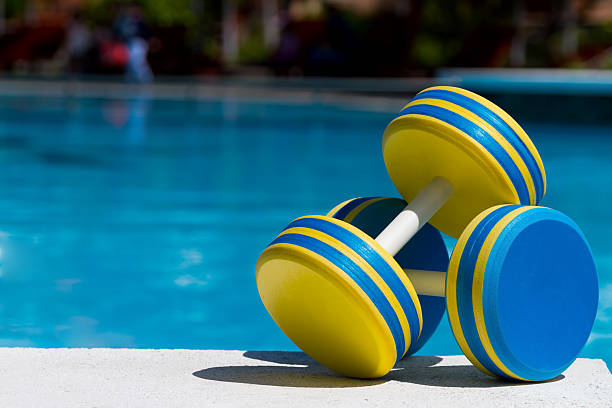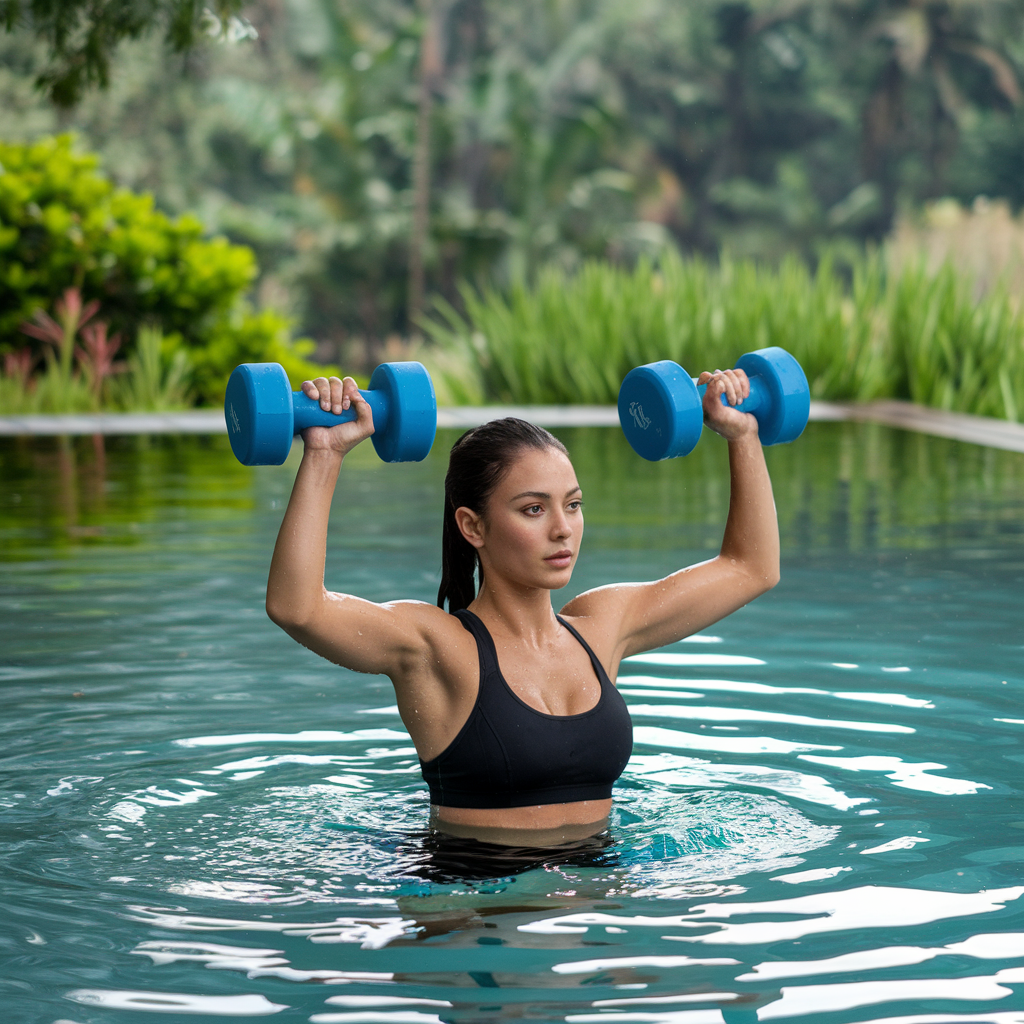Let’s dive into the world of water dumbbells. These are like regular dumbbells. But, instead of having heavy stuff like metal, they’re filled with water! Let’s explore more:
Basic Concepts
Water dumbbells are for exercise. Building strength and toning muscles are their common uses. They look like regular dumbbells.
But, they have a unique feature: they’re filled with water. This makes them lighter and more versatile.
How It Started
People wanted gentle ways to exercise. This led to the idea of water dumbbells. They wanted something gentle on the joints.
But, it also had to be good for strength. So, clever inventors came up with the idea. They used water for resistance.
Evolution Over Time
Water dumbbells have come a long way since their creation. Initially, they were simple in design and function.
But over time, they’ve become more complex. They come in different shapes and sizes. They even have adjustable water levels. The changes suit many fitness levels. They also suit various workout preferences.
Key Components
Water dumbbells have two main parts. The outer shell holds the water. The handles are for gripping. Some designs also include adjustable straps. They add stability during exercises.
Common Uses Today
- Water dumbbells are commonly used for:
- Aqua Aerobics: They enhance water aerobics classes, providing resistance for a full-body workout.
- Rehabilitation: Ideal for injury recovery due to their low impact.
- General Fitness: Add them to your water fitness routine. They add variety and engage muscles.
Benefits of Water Dumbbells
Water dumbbells offer a unique set of advantages. They make them a popular choice for fitness fans. These are not only effective but also fun to use.
You can use these buoyant weights in a pool, lake, or ocean. They can enhance your workout. Keep it simple. Stay hydrated. And enjoy your aquatic fitness journey!
Let us take an in-depth look at some of these perks:
Low Impact Exercise
Water dumbbells offer a great workout. It is low-impact. Here’s why:
Joint-Friendly: Water is easy on the joints. It reduces impact. So, it’s great for people with joint issues or recovering from injuries.
Gentle Resistance: Water dumbbells provide gentle resistance. This is different from traditional dumbbells. They can strain joints and muscles. This allows you to work out without putting excessive stress on your body.
Increased Muscle Engagement
Water resistance engages more muscles. It does this more than regular air-based exercises. Here’s how:
Constant Resistance: Water dumbbells provide constant resistance. They resist you in all directions as you move them through the water.
Stabilization Muscles: Stabilization muscles keep balance and control. They include the core, back, and shoulders.
Full-Body Activation: Water dumbbell exercises work the upper and lower body. They work on muscles in both areas. They do so at the same time. They promote overall strength and endurance.
Versatility in Workouts
Water dumbbells allow for a wide range of exercises. Here are some effective ones:
- Water Bicep Curls:
- Stand in chest-deep water.
- Hold the dumbbells with your arms extended.
- Do bicep curls by bending your elbows. Lift the weights onto your shoulders.
- The water resistance challenges your biceps and forearms.
- Leg Lifts:
- Hold the water dumbbells at your sides.
- Lift one leg at a time, extending it forward and then to the side.
- The water resistance targets your hip flexors, quads, and glutes.
- Water Push-Ups:
- Place your hands on the dumbbells in a push-up position.
- Perform push-ups while keeping the weights submerged.
- This engages your chest, triceps, and core.
Choosing the Right Water Dumbbells
When choosing water dumbbells, consider a few key factors. They will ensure you get the most from your workouts. Let’s explore:
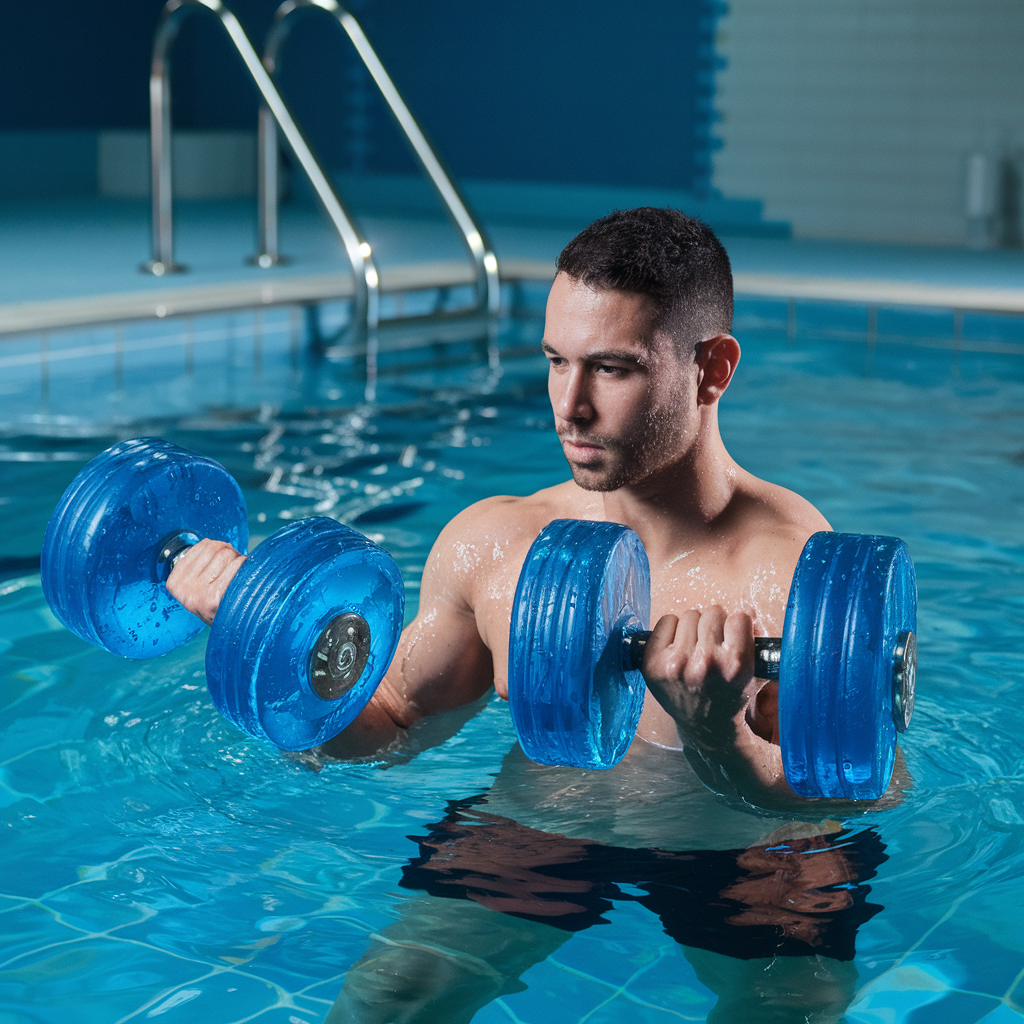
Weight Selection
Picking the right weight for your water dumbbells is key. It makes for a good and safe workout. Here’s a simple guide. It will help you pick the right weight based on your fitness level:
Beginners: If you’re new to exercising or have limited strength, start with lighter weights. This could be anywhere from 1 to 5 pounds per dumbbell.
Intermediate: If you’ve been exercising often and are fairly strong, choose medium dumbbells. They usually range from 5 to 10 pounds each.
Advanced: You may need heavier dumbbells if you are very strong and fit. These range from 10 to 20 pounds or more.
You must choose a weight that challenges you. But, it should not cause strain or discomfort. Start with lighter weights. Increase them. Do this as you get stronger. And as you get more comfortable with the exercises.
Material and Design
Water dumbbells come in various materials and designs. Each has its unique benefits and features. Here’s an overview of the most common options available on the market:
Foam: Foam water dumbbells are lightweight. They are easy to grip. This makes them ideal for beginners or those with sensitive hands. They’re usually less durable than other materials. But, they have excellent buoyancy for water workouts.
Plastic: Plastic water dumbbells are tough. They resist water damage. So, they work for both pool and land exercises. They often have adjustable water levels. You can use them to set the resistance to your fitness level.
Neoprene: Neoprene is a coating for water dumbbells. It offers a comfy and non-slip grip. This makes them ideal for intense workouts. The neoprene coating adds durability. It also adds water resistance. It ensures long-lasting performance.
Inflatable: Inflatable water dumbbells are lightweight. They are also portable. They are great for travel or on-the-go workouts. You can inflate and deflate them easily. This lets you adjust the resistance by adding or removing water.
How to Use Water Dumbbells
Water dumbbells are versatile and fun to use for a variety of exercises. Let’s explore different ways to add them to your workouts.
Warm Up Exercises
Before your main workout, you must warm up your muscles. This prevents injury and prepares them for exercise. Here are some simple warm-up routines you can do with dumbbells:
Water Arm Circles: Do water arm circles. Stand in shoulder-depth water. Hold a water dumbbell in each hand. Extend your arms out to the sides, shoulder height.
Then, make circular motions with them. Start with small circles. Gradually make them larger as you warm up your shoulders.
Water Leg Lifts: Stand in waist-deep water and hold a water dumbbell in each hand. Lift one leg straight in front of you.
At the same time, raise the opposite arm out to the side. Move your legs and arms in turn. Do it in a controlled way to warm up your lower body and core muscles.
Strength Training
Water dumbbells are great for building strength. They also tone muscles. Here are some examples of strength exercises. They target different muscle groups.
Water Bicep Curls: Do water bicep curls in waist-deep water. Hold a water dumbbell in each hand, palms facing ahead. Keep your elbows close to your sides. Curl the dumbbells towards your shoulders. Then, lower them. Repeat for a set number of repetitions to target your biceps.
Water Squats: Hold a water dumbbell in each hand. Stand with your feet shoulder-width apart in chest-deep water. Lower your body into a squat position, keeping your chest up and knees behind your toes. Push through your heels to return to the starting posture, then repeat.
Cardiovascular Workouts
In addition to strength training, you can also use water dumbbells for cardio. They improve endurance and burn calories. Here are some cardio exercises. You can do them using water dumbbells:
Water Jogging: Hold a water dumbbell in each hand and jog in place in chest-deep water. Focus on lifting your knees high. Pump your arms to raise your heart rate and engage your muscles. You can vary the intensity. Just speed up or slow down.
Water Jumping Jacks: Hold a water dumbbell in each hand. Stand with your feet together in water that is at shoulder depth. Do jumping jacks. Jump your feet out to the sides.
At the same time, lift your arms high. Continue for a set period to get your heart pumping and your muscles working.
Getting Started with Water Dumbbells
The next part is about getting started with water dumbbells. Here are some basic exercises for beginners. It also includes tips for proper form and technique.
Basic Exercises for Beginners
- Water Dumbbell Bicep Curls:
- Stand in shoulder-depth water with feet hip-width apart.
- Hold a water dumbbell in each hand, palms facing forward.
- Keep your elbows close to your body. Slowly curl the dumbbells up towards your shoulders.
- Return the dumbbells to their initial position with control.
- Aim for 2-3 sets of 10–12 repetitions.
- Water Dumbbell Shoulder Press:
- Stand with your feet shoulder-width apart. Do so in chest-deep water.
- Hold a water dumbbell in each hand at shoulder height. Hold them with hands facing forward.
- Press the dumbbells overhead until your arms are fully extended.
- Slowly lower the dumbbells back to shoulder height.
- Perform 2-3 sets of 10–12 repetitions.
- Water Dumbbell Chest Flyes:
- Stand in chest-deep water. Stagger your feet for stability.
- Hold a water dumbbell in each hand with your arms extended in front of you.
- Open your arms wide to the sides, keeping a slight bend in your elbows.
- Slowly gather the dumbbells in front of your chest.
- Complete 2-3 sets of 10–12 repetitions.
Tips for Proper Form and Technique
Maintain Good Posture: Stand tall, shoulders back. Keep your core engaged during each exercise. Avoid slouching or leaning forward. This can strain your back and shoulders.
Controlled Movements: Focus on doing each exercise slowly. Use controlled movements. They engage muscles and reduce injury risk. Avoid using momentum to raise dumbbells.
Breathe Properly: Remember to breathe steadily. Do so rhythmically during each exercise. Breathe in as you lower the dumbbells. Also, breathe out as you lift them.
Start Light: Start with light water dumbbells. Use them to master form and technique. Then, move on to heavier weights. It’s better to focus on quality reps. Don’t lift heavy weights with poor form.
Listen to Your Body: Notice any pain or strain during exercises. Adjust accordingly. If you feel pain, stop. Ask a fitness pro or healthcare provider.
Common Mistakes to Avoid
Remember, safety and good technique are vital. They are key to a successful water dumbbell workout. Enjoy the process, and make every splash count!
Here’s how we can expand the part about common mistakes. It should include pitfalls and corrections.
Overestimating Buoyancy: Many beginners make this mistake. They think water dumbbells provide little resistance. They do this because the dumbbells are buoyant. This can lead to bad workouts. They will make slow progress.
Incorrect Grip: Holding water dumbbells wrong reduces their effectiveness. It also raises the injury risk. Don’t grip them too tightly or loosely. Ensure you position your hands correctly. They should be on the handles.
Improper Technique: Misusing them can reduce the benefits of dumbbell exercises. It can even lead to strain or injury. Pay attention to proper posture. Also, watch your range of motion and movement control in each exercise.
Pitfalls to Watch Out For
Skipping Warm-Up: Not warming up before using water dumbbells is dumb. It can raise the risk of muscle strain and injury. Always start your workout with a quick warm-up. It prepares your muscles and joints for exercise.
Overexertion: Overexertion happens when you push yourself too hard. Or, you try hard exercises first. But, you should master the basics. It can result in fatigue, discomfort, or injury. Listen to your body. Increase your workout’s intensity slowly over time.
Inconsistent Routine: An inconsistent routine can slow your progress. This is especially true with water dumbbells. This happens if you skip workouts or neglect some muscles. Try to be consistent in how you train. This will lead to the best results.
How to Correct Common Errors
Educate Yourself: Take the time to learn the right technique. Do this for each dumbbell exercise. Consult reliable sources. These include videos or fitness pros. Use them to make sure you’re doing each movement correctly.
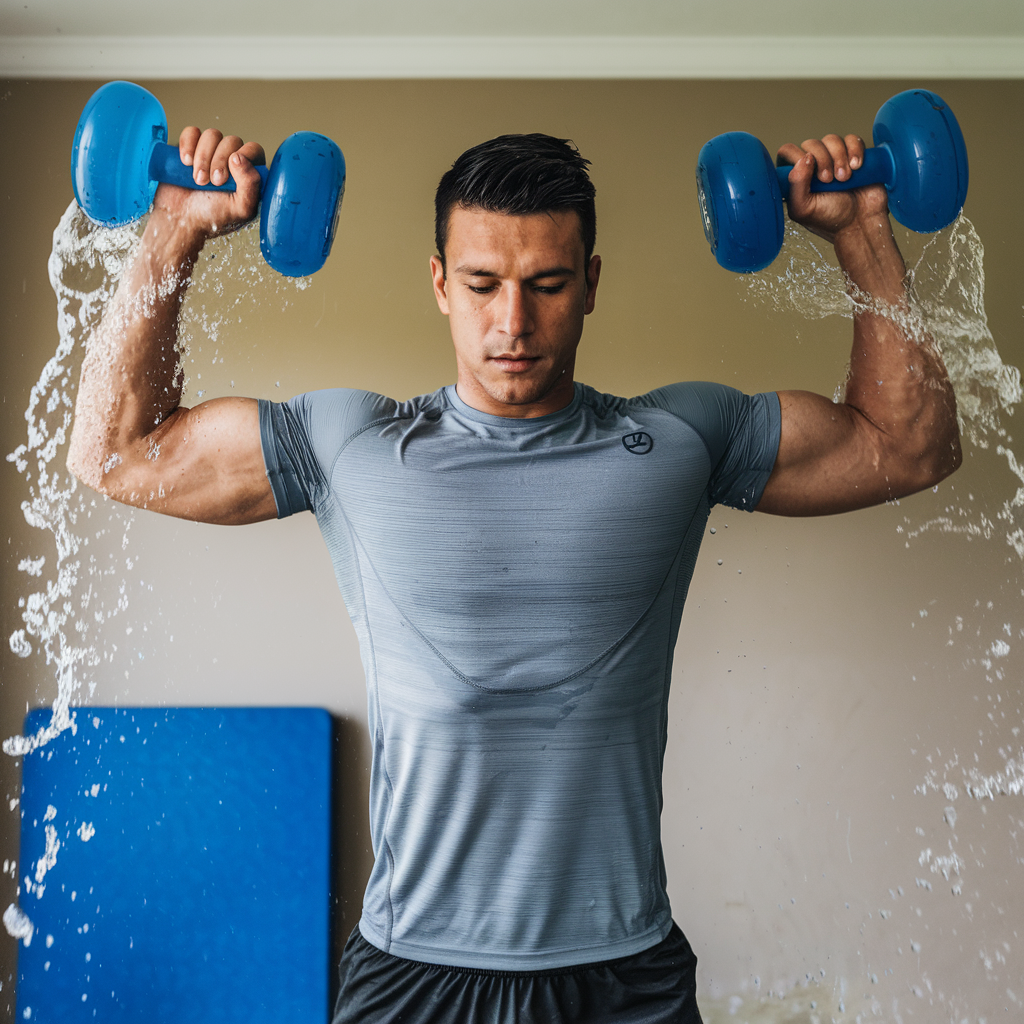
Start slowly: If you struggle with an exercise or feel pain, don’t be afraid to scale back. Start with lighter weights or simpler variations. Focus on mastering proper form. Do this before raising the intensity.
Seek Feedback: You can work with a certified personal trainer. Or, you can attend group fitness classes. They will give you feedback on your technique. And, they’ll give personal tips for improvement.
Safety Tips and Precautions
Using water dumbbells can be safe and effective. But, it’s essential to follow safety guidelines. This prevents injury and ensures a positive experience. Let’s go over some important tips:
Proper Form
You must keep proper form. It prevents injuries and maximizes your workout. Here’s how to ensure proper form when using water dumbbells:
Maintaining Alignment: Pay attention to your body alignment during exercises. Keep your spine straight. Keep your shoulders relaxed. Keep your core tight. This will avoid straining your joints.
Avoiding Strain: Start with lighter weights. Gradually increase them as you build strength. Avoid overexerting yourself. Listen to your body’s signals. If you encounter pain or discomfort, stop exercising.
Consulting a Professional
If you’re new to water dumbbells or have health concerns, ask a fitness pro for guidance. Here’s how they can help:
Fitness Instructor Guidance: Consider working with a certified fitness instructor. They can teach you the right techniques. They can give you personalized guidance. Based on your fitness goals and abilities, you will determine it.
Addressing Specific Health Concerns: If you have any health issues or injuries, talk to a doctor. Do this before starting a new exercise program. They can offer tailored advice to ensure your safety and well-being.
Enjoying the Experience
Staying safe doesn’t mean you can’t have fun! Here are some tips for enjoying your water dumbbell workout:
Staying Hydrated: Drink lots of water before, during, and after your workout. Do this, especially if you’re exercising in the water.
Celebrating Progress: Celebrate your progress. Take pride in your accomplishments. You can acknowledge your achievements. It could be mastering a new exercise or reaching a fitness milestone. Enjoy the journey to a healthier, stronger you.
User Experience and Recommendations
Let’s discuss the user experience (UX) for water dumbbells. We’ll give you some tips for making the most of your aquatic fitness journey.
User Experience with Water Dumbbells
Sensory Experience: Exercising with water dumbbells is a unique experience. It engages the senses. The water’s resistance adds an extra challenge to your movements.
But its buoyancy makes exercises feel less hard on your joints. It creates a feeling of weightlessness.
Refreshing Environment: Exercising in the water can be refreshing. It’s a change from traditional land-based workouts. The cold water helps to maintain your body temperature.
It also soothes you during your workout. This is particularly true on warm days.
Versatility and Creativity: Water dumbbells offer endless possibilities for creative workouts. You can perform classic strength training exercises.
Or, you can experiment with aquatic aerobics. You can tailor your routine to fit your preferences and fitness goals.
Recommendations for Optimal Results
Gradual Progression: Start slowly. Then, gradually make your water dumbbell workouts harder. Start with lighter weights and simpler exercises. Focus on mastering proper form and technique. Then, move on to more challenging movements.
Consistency is Key: You need to be consistent. It is crucial to see results with water dumbbell training. Aim to do water workouts regularly. Do them a few times a week or as part of your cross-training.
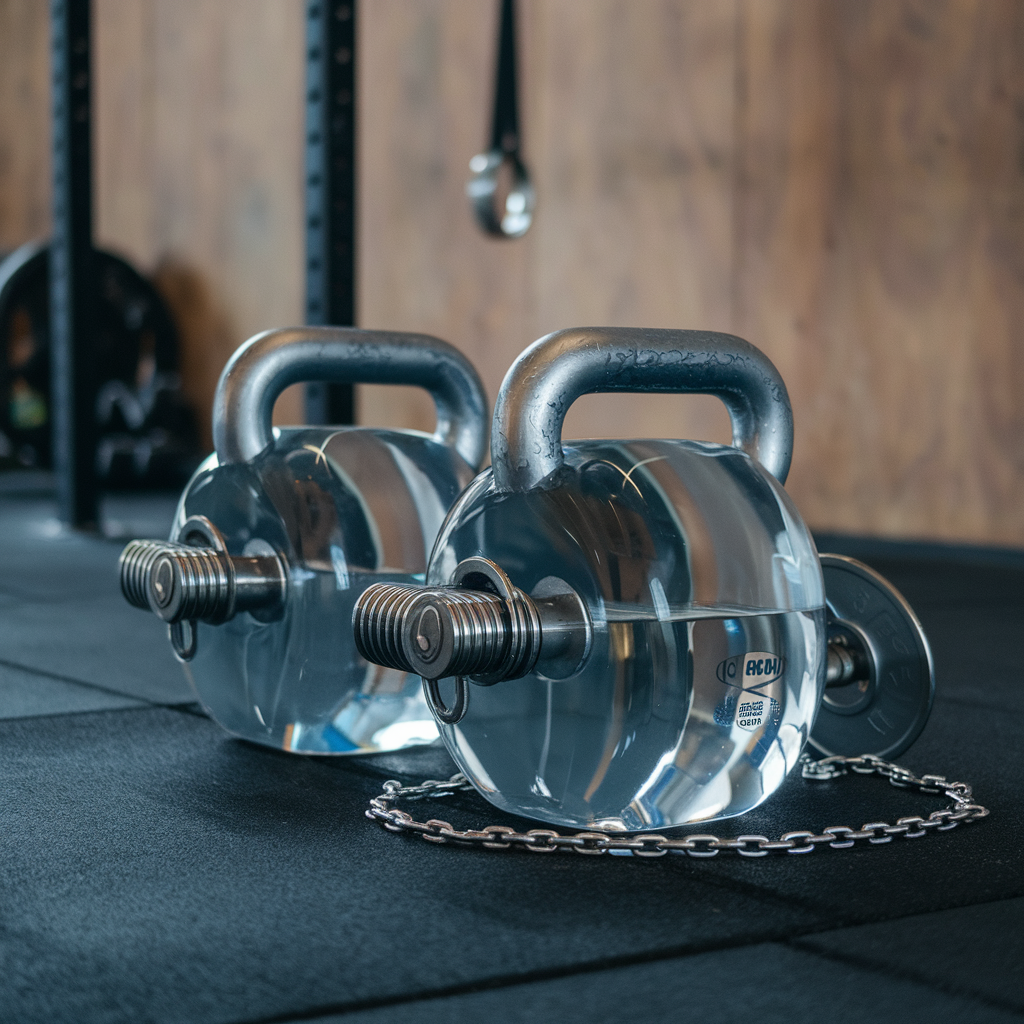
Listen to Your Body: Pay attention to how your body responds to each exercise. Adjust as needed. If you feel pain, change the movement. Or, ask a fitness pro how to avoid injury.
Stay Hydrated: Exercising in water can be deceptively hard. So, it’s vital to drink water before, during, and after your workout. Bring a water bottle with you to the poolside. Take regular breaks to drink as needed.
Variety is the Key: Keep your water workouts interesting and challenging. Do this by using a variety of exercises and equipment. Try different types of water dumbbells and resistance levels.
Also, vary your workout formats. This will keep your routine engaging and effective.
Conclusion
So, in conclusion, we’ve learned all about the amazing benefits of water dumbbells! These special exercise tools are not only fun to use but also super versatile.
They make workouts easier on our joints. They engage more muscles and offer endless options for exercises. We’ve also seen how important it is to stay hydrated and celebrate our progress.
So, why not give water dumbbells a try? Adding them to our fitness routines can make us stronger and tone our muscles. They’re also a blast!
So, let’s dive in and get moving with water dumbbells for a healthier, happier us!

